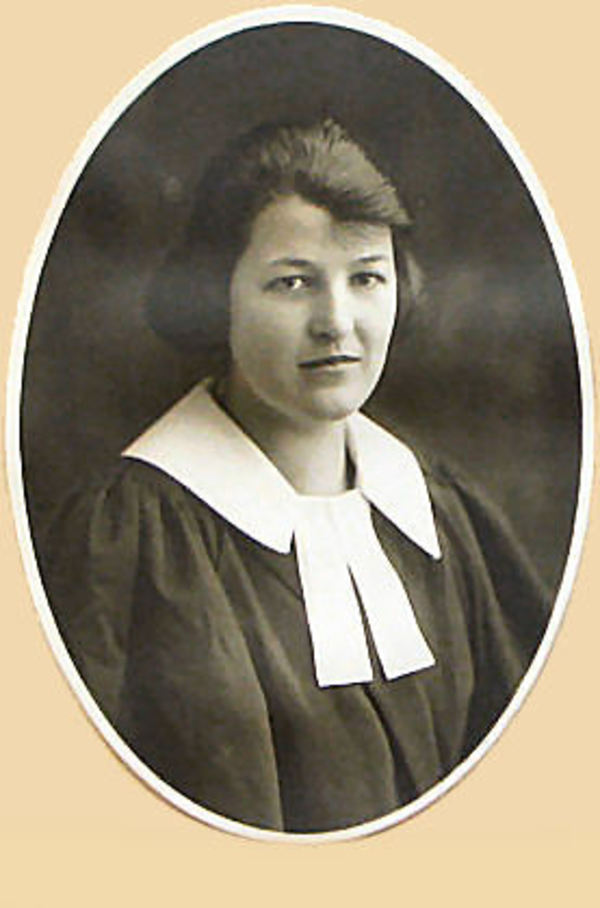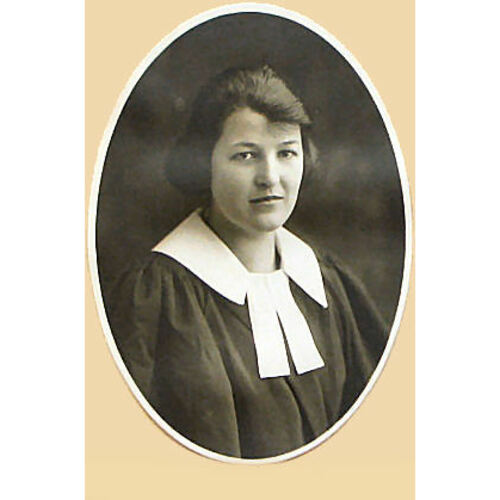
Source: Link
SHEPPARD, EDITH MARY PECKHAM (Revell), lawyer; b. 3 Aug. 1900 in Toronto, daughter of Charles Henry Sheppard and Ellen Frances Stocking; m. 14 June 1929 Captain Alfred John Revell in Bombay (Mumbai), India, and they had two children; d. 16 Nov. 1934 in Bangalore, India.
Edith Sheppard’s grandfather William Joseph Sheppard built the family fortune as general manager and president of the Georgian Bay Lumber Company, the dominant firm in the pine-timber trade of Georgian Bay, Ont., at the height of its prosperity. After the industry moved on, in 1920 the company closed its last mill, at its headquarters in Waubaushene, though it continued in name for a number of years. Diversified investments provided substantial wealth for the family, including Edith’s father, Charles, who had run the business with his father and brothers and had retired to Aurora as operations wound down.
The Sheppard family was committed to education for women: “My father …,” Edith noted in a letter to her future fiancé, “thinks it is criminal negligence on the part of parents to let their daughters grow up without knowing how to do anything.” After a childhood at Waubaushene and in company lumber camps, Sheppard attended Havergal College in Toronto, a private girls’ school, where upon graduation in 1918 she won the gold medal for general proficiency, and then the University of Toronto (ba 1921). Her university yearbook commented that she was “ready for anything under the sun,” and she became part of a surge of women entering into the field of law that had begun during the First World War. Eleven women had become lawyers in Ontario between 1897 [see Clara Brett Martin*] and 1918; by 1933, when about 2,500 lawyers practised in Ontario, 66 more women had been called to the bar. Sheppard was accepted into the three-year program administered by the Law Society of Upper Canada at Osgoode Hall in Toronto [see Newman Wright Hoyles*]; simultaneously she was articled to Leighton Goldie McCarthy*, who from 1916 to the 1940s was senior partner at McCarthy and McCarthy. After being called to the bar with honours in January 1925, as the 43rd woman lawyer in Ontario, she remained with the firm on salary, one of the first women to practise in a prominent corporate-law firm in a major Canadian city.
Like many male law students, Sheppard had found her position through family and business connections: since its incorporation in 1871, the Georgian Bay Lumber Company had been a client of the McCarthy firm. She also benefited from the liberal attitude of Leighton McCarthy. In an era when most Canadian law firms had no female lawyers, McCarthy accepted Sheppard and eventually several more women as lawyers and as articling clerks, the latter including Gretta Jean Wong, the first Chinese Canadian woman to be called to the bar. McCarthy reportedly said in 1928 that Sheppard had been “the best student we ever had.”
Despite her father’s suggestion that she open her own law office, Sheppard concluded that as a woman practising alone she would “never get a client from now until doomsday,” whereas at the McCarthy firm she was able to do challenging work that she greatly enjoyed, despite the reaction of some clients (“poor old fogies”) who were shocked to encounter a woman lawyer. Much of her work was for the firm’s principal client, the Canada Life Assurance Company, of which Leighton McCarthy was then vice-president and general counsel. She also handled legal matters for the Sheppard family companies.
At the McCarthy firm, where in 1925 she reported working with seven other lawyers, four law students, and a staff of ten, Sheppard observed the hierarchy of mostly male lawyers and students and mostly female stenographers, whom she described as “not the young flapperish sort – but girls from nice families whose fathers have died and who have to earn their own living.” Leighton McCarthy’s practice involved high-level political and business dealings, such as facilitating the industrial developments of American aluminum baron Arthur Vining Davis at Arvida (Saguenay), Que. (“They are going to build a town of 40 or 50 thousand,” Sheppard commented. “It will seem funny to have an industry like that spring up in the forest solitudes.”) Leighton McCarthy’s partner and cousin, D’Alton Lally McCarthy*, the firm’s senior litigator, shared courtroom gossip with Sheppard and fuelled her doubts about the impartiality of the Ontario courts. Future senior partner (and senator) Salter Adrian Hayden struck her as “very full of his own importance.” Under his leadership in the 1940s and early 1950s, there would be no women lawyers at McCarthy and McCarthy.
Sheppard was a member of the Women’s Law Association of Ontario (WLAO) and active in a community of young professional women in Toronto, including her sister Ellen Margaret Buchanan Sheppard, a chemist at the Banting Institute, and her law-school friend Vera Lillian Parsons*, one of the first Canadian women lawyers to build a criminal-defence practice. Like many of her circle, Sheppard accepted that for women marriage and employment remained largely incompatible. In 1927 a WLAO survey estimated that about half of Ontario’s women lawyers, most of whom had qualified since 1918, had left active practice “for matrimony.” In 1928, when Sheppard became engaged to an Englishman whom she had met on a European holiday, she gave up her career, resigning from McCarthy and McCarthy in the spring of 1929 and letting her Law Society membership lapse.
In May 1929 Sheppard sailed to India. Her fiancé, Alfred John Revell, was a captain in the 1st Madras Pioneers of the Indian army. They were married at Bombay in June and lived in Bangalore, where he was stationed. In India, Edith Sheppard Revell bore two children, a daughter and a son, both of whom would have academic careers in Canada. But health problems that had necessitated several leaves from her law practice in Toronto recurred in India, and she died in Bangalore in 1934 after an appendectomy.
The author is grateful to Elizabeth Revell, daughter of Edith Mary Peckham Sheppard (Revell), and to Elizabeth’s late brother and sister-in-law, Professor Ernest John and Ann Margaret Revell, for sharing documents and information and granting permission to quote from their mother’s correspondence.
Law Soc. of Ont. Arch. (Toronto), “Crossing the bar” exhibition reference files; Edith Sheppard membership information (OBBRP record); PF58 (Women’s Law Association of Ontario fonds), scrapbook 1919–34. McCarthy Tétrault LLP, arch. (Toronto), Sheppard, Edith file (holds copies of excerpts from Edith Sheppard’s unpublished letters and diary entries, 1925–29, originals in the possession of the Revell family); Partnership agreements - 001, articles of partnership – Leighton, Lally, and Frank McCarthy, 31 May 1928; Video cassettes - 002, interview with Beverley Mathews by J. H. C. Clarry, 24 Aug. 1995. UTARMS, A1973-0026 (Univ. of Toronto, dept. of graduate records), box 412. Globe, 6 Aug. 1900: 10, 18 June 1918: 4, 16 Jan. 1925: 13. J. T. Angus, A Deo victoria: the story of the Georgian Bay Lumber Company, 1871–1942 (Thunder Bay, Ont., 1990). Constance Backhouse, “Gretta Wong Grant: Canada’s first Chinese-Canadian female lawyer,” Windsor Yearbook of Access to Justice (Windsor, Ont.), 15 (1996): 3–46. Abby Bushby, “The early years: sources of an enduring tradition: the Women’s Law Association of Ontario, 1919–1950” (paper prepared for the 80th anniversary of the WLAO, Toronto, 2000). Curtis Cole, “A developmental market: growth rates, competition and professional standards in the Ontario legal profession, 1881–1936,” Canada–United States Law Journal (Cleveland, Ohio), 6 (1983): 125–39 (an addendum to this article was published in the same journal in vol.7 (1984): 231–45). Christopher Moore, McCarthy Tétrault: building Canada’s premier law firm, 1855–2005 (Vancouver, 2005).
Cite This Article
Christopher Moore, “SHEPPARD, EDITH MARY PECKHAM (Revell),” in Dictionary of Canadian Biography, vol. 16, University of Toronto/Université Laval, 2003–, accessed January 12, 2026, https://www.biographi.ca/en/bio/sheppard_edith_mary_peckham_16E.html.
The citation above shows the format for footnotes and endnotes according to the Chicago manual of style (16th edition). Information to be used in other citation formats:
| Permalink: | https://www.biographi.ca/en/bio/sheppard_edith_mary_peckham_16E.html |
| Author of Article: | Christopher Moore |
| Title of Article: | SHEPPARD, EDITH MARY PECKHAM (Revell) |
| Publication Name: | Dictionary of Canadian Biography, vol. 16 |
| Publisher: | University of Toronto/Université Laval |
| Year of publication: | 2023 |
| Year of revision: | 2023 |
| Access Date: | January 12, 2026 |



